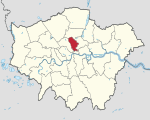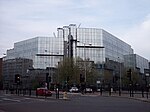Railway Clearing House
1842 establishments in the United Kingdom1955 disestablishments in the United KingdomHistory of rail transport in the United KingdomStandards organisations in the United KingdomUse British English from January 2018

The Railway Clearing House (RCH) was an organisation set up to manage the allocation of revenue collected by pre-grouping railway companies for the conveyance of passengers and goods over the lines (or using the rolling stock) of other companies. It went on to become the major regulatory body overseeing the day-to-day running of railways in Great Britain and setting common standards for railway companies, which ensured their safety and interoperability. The RCH also produced fare structures governing many aspects of rail transport at a national level and set limits on price increases for passenger travel.
Excerpt from the Wikipedia article Railway Clearing House (License: CC BY-SA 3.0, Authors, Images).Railway Clearing House
Eversholt Street, London St Pancras (London Borough of Camden)
Geographical coordinates (GPS) Address Nearby Places Show on map
Geographical coordinates (GPS)
| Latitude | Longitude |
|---|---|
| N 51.5315 ° | E -0.1357 ° |
Address
Eversholt Street
NW1 1BU London, St Pancras (London Borough of Camden)
England, United Kingdom
Open on Google Maps









